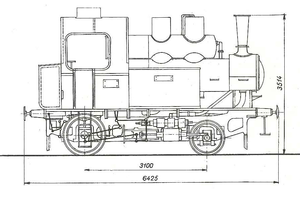MÁV MIa
| MÁV MIa MÁV 11 MÁV175 CFR 11 JDŽ 160 |
|
|---|---|
|
Outline sketch
|
|
| Numbering: | MAV 11.001-031 175.002, 009, 012, 014 |
| Number: | MAV: 31 |
| Manufacturer: | MÁVAG , Budapest |
| Year of construction (s): | 1910-1913 |
| Retirement: | until 1963 |
| Axis formula : | 1A n2vt |
| Gauge : | 1435 mm ( standard gauge ) |
| Length over buffers: | 5,425 mm |
| Height: | 3,750 mm |
| Width: | 2,450 mm |
| Total wheelbase: | 3,100 mm |
| Smallest bef. Radius: | 110 m |
| Service mass: | 19.13 t |
| Friction mass: | 9.5 t |
| Wheel set mass : | 9.62 t |
| Top speed: | 60 km / h |
| Indexed performance : | 188 hp |
| Starting tractive effort: | 17.8 kN |
| Driving wheel diameter: | 1,040 mm |
| Impeller diameter: | 875 mm |
| Control type : | Heusinger |
| Number of cylinders: | 2 |
| HD cylinder diameter: | 220 mm |
| LP cylinder diameter: | 330 mm |
| Piston stroke: | 400 mm |
| Boiler overpressure: | 16 bar |
| Number of heating pipes: | 80 |
| Heating pipe length: | 2,000 mm |
| Grate area: | 0.78 m² |
| Evaporation heating surface: | 31 m² (in contact with water) |
| Water supply: | 2 m³ |
| Brake: | Westinghouse brake |
| Particularities: | Brotan kettle |
The MÁV MIa , from 1911 MÁV 11 , from 1957 MÁV 175 , was a tank locomotive series of the Hungarian State Railways MÁV for branch line traffic on a weak superstructure. It was developed from the MÁV MI and, like this one, was intended for light passenger trains on branch lines .
history
The locomotives were supposed to enable more economical passenger train traffic around 1910 , as was done with the MÁV XII with predominantly mixed trains. The new locomotive should be superior to the MÁV XII, especially in terms of speed and pulling power . A first series of 23 locomotives were delivered in 1910, and the remaining eight machines followed in 1913.
Locomotives of this series were also used in the stock of the CFR and the JŽ . It is unknown whether these were included in the deliveries.
On branch lines, mainly used around Miskolc , Debrecen , Nyíregyháza and Mezőtúr , they carried 100 t train load on a flat stretch at a speed of 60 km / h.
Competition soon arose in the form of increasing motorization on branch lines and the use of the more powerful MÁV 22 series . This resulted in relocations, especially in the area of Dombóvár , Siklós and Kaposvár . Many machines were decommissioned or sold even before 1945.
At the time of the change to the MÁV class 175 in 1957, four locomotives were still available. They were given the numbers 175 002, 009, 012, 014 . The locomotives were all scrapped between 1959 and 1963.
technical features
In contrast to the MÁV MI , the wheelsets were interchanged in this series, the wheelset was arranged at the front and the drive wheel set at the rear. The wheelbase was smaller and other details such as the coal box were designed differently.
The composite locomotives were equipped with a bread tank. With two cylinders, this required a special starting device. The steam consumption was greater than with the twin machines.
After 1925 the engine was converted to a twin engine and the machines received a small tube superheater . This reduced the evaporation heating surface to 23.5 m² and an additional 7 m² superheater heating surface. The boiler pressure changed to 14 or partially 15 bar. The pulling force increased to 21 kN.
See also
literature
- Mihály Kubinszky (Ed.): Hungarian Locomotives and Railcars , Akadémiai Kiadó, Budapest, 1975, ISBN 963-05-0125-2 .
Individual evidence
- ↑ Mihály Kubinszky (Ed.): Hungarian Locomotives and Railcars , Akadémiai Kiadó, Budapest, 1975, ISBN 963-05-0125-2 , page 149
- ↑ Mihály Kubinszky (Ed.): Hungarian Locomotives and Railcars , Akadémiai Kiadó, Budapest, 1975, ISBN 963-05-0125-2 , page 147
- ↑ Mihály Kubinszky (Ed.): Hungarian Locomotives and Railcars , Akadémiai Kiadó, Budapest, 1975, ISBN 963-05-0125-2 , page 199

